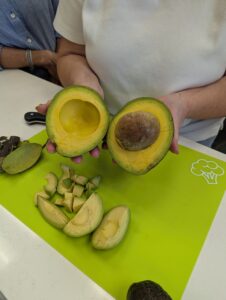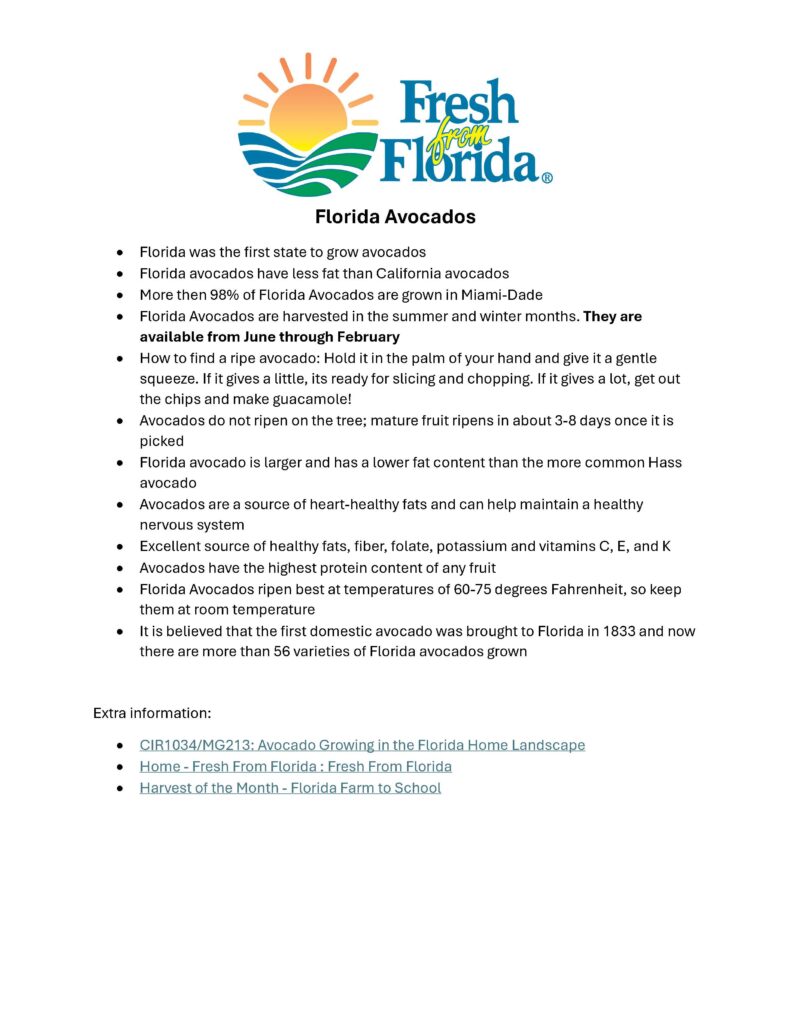Avocados From Florida
go.ncsu.edu/readext?1073608
en Español / em Português
El inglés es el idioma de control de esta página. En la medida en que haya algún conflicto entre la traducción al inglés y la traducción, el inglés prevalece.
Al hacer clic en el enlace de traducción se activa un servicio de traducción gratuito para convertir la página al español. Al igual que con cualquier traducción por Internet, la conversión no es sensible al contexto y puede que no traduzca el texto en su significado original. NC State Extension no garantiza la exactitud del texto traducido. Por favor, tenga en cuenta que algunas aplicaciones y/o servicios pueden no funcionar como se espera cuando se traducen.
Português
Inglês é o idioma de controle desta página. Na medida que haja algum conflito entre o texto original em Inglês e a tradução, o Inglês prevalece.
Ao clicar no link de tradução, um serviço gratuito de tradução será ativado para converter a página para o Português. Como em qualquer tradução pela internet, a conversão não é sensivel ao contexto e pode não ocorrer a tradução para o significado orginal. O serviço de Extensão da Carolina do Norte (NC State Extension) não garante a exatidão do texto traduzido. Por favor, observe que algumas funções ou serviços podem não funcionar como esperado após a tradução.
English
English is the controlling language of this page. To the extent there is any conflict between the English text and the translation, English controls.
Clicking on the translation link activates a free translation service to convert the page to Spanish. As with any Internet translation, the conversion is not context-sensitive and may not translate the text to its original meaning. NC State Extension does not guarantee the accuracy of the translated text. Please note that some applications and/or services may not function as expected when translated.
Collapse ▲A few weeks ago our Extension Master Food Volunteers were testing recipes for our
Cooking at Home class series. While shopping for avocados they noticed a different size and shaped avocado in our local markets. This got us investigating.
 A quick check on the internet shared that these larger and rounder avocados are called Florida Avocados. So, we reached out to our colleagues at University of Florida/IFAS Extension in Miami-Dade County. Jeff Wasielewski, Commercial Topical Fruit Extension Agent graciously answered our questions.
A quick check on the internet shared that these larger and rounder avocados are called Florida Avocados. So, we reached out to our colleagues at University of Florida/IFAS Extension in Miami-Dade County. Jeff Wasielewski, Commercial Topical Fruit Extension Agent graciously answered our questions.
Wasielewski explained that those large glossy green smooth-skinned avocados are
indeed called Florida Avocados. This type of avocado is grown in Florida and mostly in Miami-Dade County. They are larger than the Hass avocado— which is the pear-shaped avocado with which we are most familiar. Most Haas avocados we see in our markets are grown in California or Mexico. Due to a different climate from south Florida, they can’t grow the Hass avocado and vice versa California and Mexico can’t grow the Florida Avocado.
However, we noted that the avocado we purchased had a sticker on it that said it was
from the Dominican Republic. Wasielewski says if they aren’t grown in Florida, they are simply called green skinned avocados. It was really difficult for us to tell if it was ripe enough. We kept it for a few days but didn’t seem to get softer. Wasielewski says that perhaps it could have been picked early when it was not mature. He shared that Florida has a strict picking schedule that only lets farmers pick and sell fruit that has reached a certain size or weight that ensures the fruit will mature and ripen properly. It is believed that the first domestic avocado was brought to Florida in 1833 and now there are more than 56 varieties of avocados grown in south Florida. California grows 90% of the US avocado crop.
According Emily Bruce with the Division of Marketing and Development with the Florida Department of Agriculture and Consumer Services, Florida Avocados are harvested in the summer and winter months and are available from June through February. They don’t ripen on the tree and mature fruit will ripen 3-8 days once it is picked. Florida Avocados ripen best at temperatures of 60-75 degrees Fahrenheit, so keep them at room temperature. After the fruit ripens it may be stored in the refrigerator. To determine if an avocado is ripe, hold it in the palm of your hand and give it a little squeeze. If it gives a little, it is ready to eat.

Extension Master Food Volunteers with Family & Consumer Science agent Avery Ashley, cutting avocados
Another interesting difference is that these Florida Avocados are less dense, have a
higher water content and are lower in fat than Haas avocados. A 3.5 ounce (100 g)
serving of Florida Avocados have about 9 grams of fat (75% is unsaturated), 5 grams of dietary fiber and 112 calories. Avocados contain folate, potassium and vitamins C, B6, E and K and have the highest protein content of any fruit.
So, what did we think of our green skinned avocado from the Dominican Republic? We had mixed reviews, some of us liked it and felt it was creamy and flavorful. Others said it didn’t compare to a Hass avocado. It really wasn’t ripe, so it’s probably not a fair test. I think we’ll need to look for one from Florida, allow it to ripen correctly and do another test.
Florida Avocados
- Florida was the first state to grow avocados
- Florida avocados have less fat than California avocados
- More than 98% of Florida Avocados are grown in Miami-Dade
- Florida Avocados are harvested in the summer and winter months. They are available from June through February
- How to find a ripe avocado: Hold it in the palm of your hand and give it a gentle squeeze. If it gives a little, it’s ready for slicing and chopping. If it gives a lot, get out the chips and make guacamole!
- Avocados do not ripen on the tree; mature fruit ripens in about 3–8 days once it is picked
- Florida avocado is larger and has a lower fat content than the more common Hass avocado
- Avocados are a source of heart-healthy fats and can help maintain a healthy nervous system
- Excellent source of healthy fats, fiber, folate, potassium and vitamins C, E, and K
- Avocados have the highest protein content of any fruit
- Florida Avocados ripen best at temperatures of 60–75 degrees Fahrenheit, so keep them at room temperature
- It is believed that the first domestic avocado was brought to Florida in 1833 and now there are more than 56 varieties of Florida avocados grown
Extra information:
- CIR1034/MG213: Avocado Growing in the Florida Home Landscape
- Home – Fresh From Florida : Fresh From Florida
- Harvest of the Month – Florida Farm to School
Note: All produce at the grocery store should be labeled with its origin.
Resources
- The Packer: University Extension says timing is right to plant Florida avocado trees
Syracuse is a Family and Consumer Science team member and can be reached at N.C. Cooperative Extension, Brunswick County Center 910-253-2610 or by email at
clsyracu@ncsu.edu




